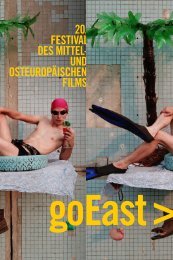goEast_2024_Katalog
Sie wollen auch ein ePaper? Erhöhen Sie die Reichweite Ihrer Titel.
YUMPU macht aus Druck-PDFs automatisch weboptimierte ePaper, die Google liebt.
The Past
A special part of the Symposium that is also the result
of processing war trauma, still fresh and aching, is the
exhibition Political Textile by Ton Melnyk and Masha
Ravlyk, co-founders of ReSew sewing cooperative from
Ukraine, as well as artists and queer feminist activists.
The exhibition features a number of textile works created
using different techniques – sewing and application
from upcycled fabrics, embroidery and other methods –
reflecting on experiences of queer people from Ukraine
facing the existential horrors of the war. The central
piece of the exhibition comprises three anti-war banners,
as an homage to Maria Prymachenko, a self-taught
Ukrainian artist who lived in the 20th century and whose
works, created in a range of media (paintings, ceramics,
embroidery), have often been referred to as “naïve” in
terms of their style. Many of Prymachenko’s works were
the artist’s reaction to her personal experience of World
War II. Ton Melnyk and Masha Ravlyk write about the
process of creating these homages: “While working on the
banners, we felt the war at a new level. Now having our
own experience, we were wondering how Prymachenko
accurately noticed and depicted the horror, anxiety, and
consequences of the war in her own way. We noticed that
manual sewing work has a therapeutic effect.”
It was important to us that the Symposium not only
feature works directly connected with non-normative
sexualities and/or gender identities – in addition, it
should also feature those contemporary experiences of
queer people from the region that are most relevant today.
These erasures and violence in the regions featured in
the Symposium were often reflected on film in complex
ways, leaving the grim impression that there is little
space beyond the boundaries of heteronormativity and
patriarchy, little hope of a queer life and future. But the
curated short-film programs show that all is not grim, far
from it in fact: luckily, queerness is nothing if not resilient.
In recent years, one of the most exciting fields for CEE film
creativity and images of queerness has been the shortfilm
form. Shorts, made with no or very small budgets
and often within webs of transnational cooperation
between younger filmmakers, reveal a diverse array of
cinematic visions, aesthetics and themes: from no-budget
DIY productions and experimental works to animations
and visually slick films, these works manage to queer the
visual landscape of these once painfully heteropatriarchal
regions. Sometimes they do still talk about sadness and
heartbreak, but queerness is also so much more. It is
solidarity, joy, playfulness, fantasy, anger, survival and
revolt.
Delving into the past of queer representation in CEE is
challenging – not because queer images did not exist,
but because they are acutely under-researched, even
among CEE scholars. Featured Symposium guest Nebojša
Jovanović wrote about this “social amnesia” and its
consequences: “Despite some precious exceptions […],
we generally persist in reluctance to foreground queer
experiences during socialism, thus obliterating them
more fully than any homophobia or criminalization of
homosexuality in the socialist countries could do” (2012:
212).
Contrary to commonly-held beliefs and old stereotypes,
non-heteronormativity and LGBT+ cinematic images
have always been a part of the vastly different CEE film
landscapes. Sometimes subtle, at other times explicit or
even radical, these images disrupted heteronormative
societies and constructed complex on-screen sexualities
and gender expressions. In the Symposium film program,
rarely-seen queer images from the past will be screened
and (re-)contextualised through lectures and talks
in order to destabilise the idea of a homophobic past
followed by a more liberal attitude towards queerness
in the post-transition period. That is not to say that
past public discourse on LGBT+ issues in CEE countries
was not riddled with stereotypes, violent homophobia,
censorship and discrimination, but it is important to
point out that queer images did exist in CEE, though often
in an ambiguous relation to public attitudes regarding
homosexuality.
Take for example FIVE MINUTES OF PARADISE / PET
MINUT RAJA (1959): when Slovenian director Igor Pretnar
was unable to secure funding for his first feature in his
home country, he went to Bosna Film, where he realised
his story about two concentration camp prisoners that
get sent to a German officer’s house to disarm a bomb.
Since it is a suicide mission, their guards leave them to it,
and the men, who have very little hope of surviving, take
the opportunity to dress up, smoke, drink and dream of
freedom. The 1950s were a prolific decade for Yugoslav
queer imagery, which was framed within the masculine
collectives featured in socialist realist films. These
films not only blurred the lines between homosocial and
queer – they also gave Yugoslavs their first images of
cross-dressing and non-closeted gays. Jovanović notes
that these films destabilise “the totalitarian-model view
of the socialist past”, which sees film and art as totally
suppressed by the regimes’ ideology and propaganda.
Instead of the idea of top-down homophobia, he proposes
that queerness was “constantly redefined, discussed and
valued at different social sites and by many social agents
in early Yugoslav socialism”. (Jovanović, 2016: 132-133)
68





